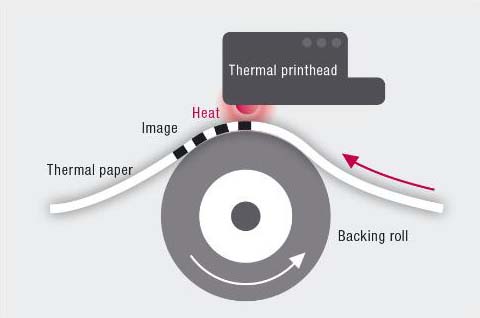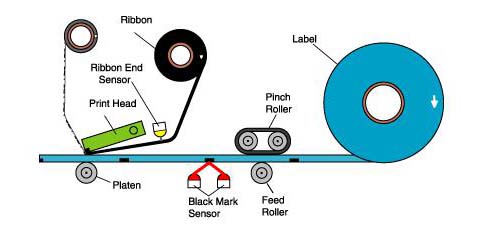What is a thermal label printer?
To understand the thermal label printer better, let's get a short brief of the thermal printing principle: a thermal label printer uses a heated thermal printhead pressed against a medium to produce black text or images. It's widely used in making labels, receipts, and barcodes in a wide range of industries. There are two types of thermal label printers, direct thermal label printers, and thermal transfer label printers.
Direct thermal label printer

Direct thermal printing technology does not use any ribbon, ink, or toner. The thermal paper moves forward under the drive of the roller of the printer. When it contacts with the print head, the heat generated by the print head melts the dye and acid on the thermal paper, and the two react chemically to produce color.
Direct thermal label printers are small and portable. Since the ink has been pre-stored on the paper, direct thermal label printers no longer need room to store and transport ink, they can be very compact. It is ideal to carry, especially for printing receipts for customers in outdoors or on vehicles. Due to its simple structure, the direct thermal printer is also very easy to maintain. Users do not need to worry about replacing the ink cartridges. They only need to replace a new roll of thermal paper when the paper runs out.
But direct thermal technology also has its disadvantages. The texts and images on the thermal labels will gradually fade after the printed media is stored for a period of time. And it can only use one color at a time.
In conclusion, a direct thermal label printer is a good choice for users who want to print information that only lasts a short period of time. It is suitable for commercial, retail, catering, logistics, and other applications.
Thermal transfer label printer

A thermal transfer label printer uses the heat on the printer head to melt and transfer the ink on the ribbon to the print medium (label, paper, or others).
Unlike direct thermal printing, thermal transfer printers are less expensive to maintain due to two factors: the durable printing materials used and the protective coating on the back of the ribbon. Moreover, thermal transfer printing is not just restricted to printing on paper. It can print on materials such as plastic, polyester, vinyl, and more, achieving perfect print quality and showing high resistance to abrasion, light, and temperature.
One of the biggest disadvantages of thermal transfer printers is the cost. The higher-end printers can be expensive. Also, the printing medium and ribbon need to be replaced continuously, which adds to the cost.
The thermal transfer printer is particularly suitable for label printing in industrial environments for its high-volume printing capacity and long shelf life of the printing content.
Which thermal label printer should we choose?
If you are looking for a thermal label printer, it is recommended that you should consider the two factors:
Required readability life of the label/print media
The environment the label will be exposed to
If you require a readability life of fewer than six months and the labels can be kept under good environmental conditions, a direct thermal label printer is a better choice for you. For those requiring a readability life of more than six months or the labels will be kept in harsh storage conditions, a thermal transfer label printer is more suitable for you.


